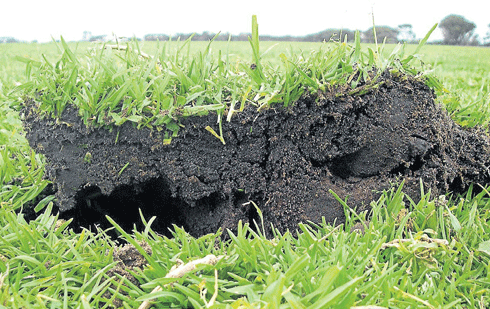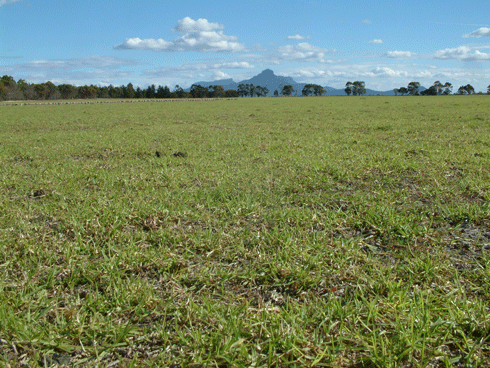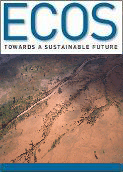
|
Published: 7 November 2012
‘Garden scourge’ may help counter livestock emissions
You often hear the argument that sheep or cattle production has a much bigger carbon footprint than crop production. But, as our research group discovered, if you take a ‘whole-farm system’ approach, the comparison can be surprising. And kikuyu grass – considered a scourge by many urban gardeners – could play a key role.

|
|
Perennial kikuyu pastures have been found to boost soil carbon in some situations. Credit:
CSIRO
|
Recent research shows that net greenhouse gas (GHG) emissions from livestock production are strongly influenced by the farming system used. In fact, some livestock production systems may emit levels of GHG comparable to cropping systems.
How is this possible? Livestock systems encourage the use of perennial pasture plants to ensure continuity of feed supply. Because perennial plants can use rainfall all year round, they may capture more carbon over time than crops or pastures that contain only annuals.
However, because perennial pastures extend the seasonal distribution of green feed, farmers can also increase their animal stocking rate. This, in turn, increases methane and nitrous oxide GHG emissions.
Thus the outcome for net farm emissions from the system in question depends on whether the additional carbon stored in the improved pasture is greater than the extra emissions that would result from any increase in stocking rate.
In other words, when considering the potential for soil-carbon storage, farmers must take into account flow-on effects that may negate the direct benefits of the new carbon store. An increase in emissions elsewhere in the system may nullify or cancel the net carbon storage benefit of perennial pastures.
Our research has focused on the use of kikuyu-based perennial pastures (Pennisetum clandestinum Hochst.) to increase soil-carbon storage in mixed crop and livestock farms.1
Our farm systems modelling shows that establishing kikuyu-based pastures on 60 per cent of farmland set aside for pasture in a mixed crop and merino sheep farm could cut annual net GHG emissions by 0.61 tonnes of carbon dioxide-equivalent per farm-hectare (t CO2-e per farm ha per year).2,3
This reduction occurred despite an increase in livestock emissions of 0.19 t CO2-e per farm ha per year caused by a 30 per cent increase in farm stocking rate after the kikuyu pasture was established.
Put another way, the amount of carbon stored in the kikuyu pastures of such a farm system will be four times greater than the increase in methane emissions, and roughly equivalent to the total livestock GHG emissions from all of the farm’s livestock.
Why is this important? Australia’s rural landscapes could make a substantial contribution to meeting national greenhouse gas reduction targets. Dr Jeff Baldock of CSIRO’s Sustainable Agriculture Flagship has suggested that farming systems can reduce net emissions by adapting to the use of perennial crops and pastures, along with no-till systems, rotational grazing and pasture cropping technologies.
The role of perennials in creating resilient agricultural systems is being investigated by CSIRO and the Future Farm Industries CRC through the latter’s Enrich project. Enrich researcher, Dr Dean Revell, has found that perennial forages can facilitate new or modified animal production systems, a diversified feedbase, and better management of environmental effects on livestock.
While there are gains to be made from improving farm carbon balance, at some point, the rate of carbon accumulation in the soil will plateau and approach a new steady state.
We have found no reports of the expected longevity of carbon capture by kikuyu pastures, but the Intergovernmental Panel on Climate Change (IPCC) suggests a default value of 20 years following a change in management practice. Other researchers consider 20 years to be conservative, and have reported net soil carbon storage in European grasslands that have remained relatively undisturbed for many decades.4
Soil carbon storage in kikuyu pastures is likely to change over time and needs to be better understood in order to determine the effect of these pastures on net farm emissions in the long-term.
Our study highlights the importance of considering all the GHG emissions implications of a change in farm management practice, and may have wider implications for the use of perennial forage species in livestock systems.
Provided that other perennial species are able to accumulate soil carbon at a rate similar to kikuyu, sowing perennial forage plants in areas of annual pastures or crops may be an important part of GHG abatement strategies.
Dr Dean Thomas, a CSIRO agricultural scientist with expertise in ruminant livestock systems, was raised on a mixed sheep/grain property on the south coast of Western Australia. He believes livestock production plays an important role in global food security because of ruminants’ ability to convert forage plants, crop residues, low-quality grains and other agricultural by-products into high-quality food protein.
More information:
‘Kikuyu over carbon’, CSIRO Rural Press magazine insert, 27 September 2012 (access PDF on this page)
Greenhouse gas abatement and carbon storage in land use systems
1 Thomas DT, Sanderman J, Eady SJ, Masters DG & Sanford P (2012) Whole farm net greenhouse gas abatement from establishing Kikuyu-based perennial pastures in south-western Australia. Animals 2, 316–30.
2 Carbon dioxide-equivalent (CO2-e) is a measure used to compare the emissions from various greenhouse gases based on their global warming potential. For example, the global warming potential for methane over 100 years is 21. This means that one million metric tonnes of methane emissions is equivalent to 21 million metric tonnes of carbon dioxide emissions.
3 The study was conducted by combining GrassGro® – a CSIRO-developed decision support tool – and the National Greenhouse Gas Inventory models.
4 Soussana JF, Allard V, Pilegaard K, et al. (2007) Full accounting of the greenhouse gas (CO2, N2O, CH4) budget of nine European grassland sites. Agricultural Ecosystems and Environment 121, 121–34.




